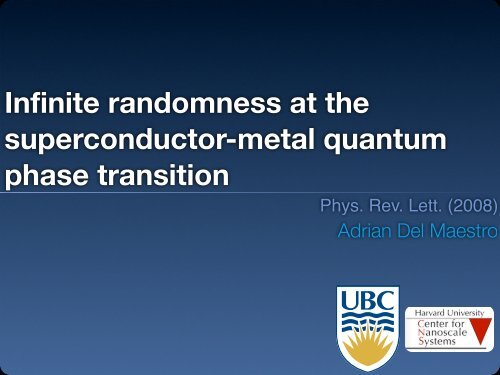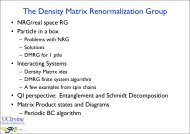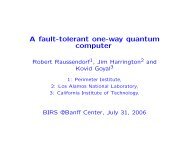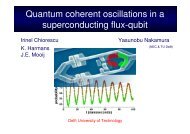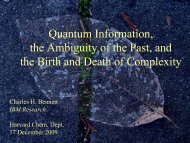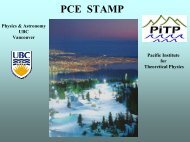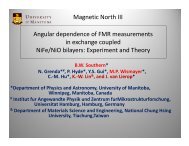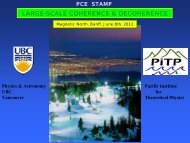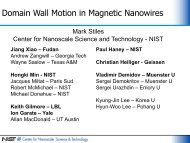Infinite randomness and the superconductor-metal transition - PiTP
Infinite randomness and the superconductor-metal transition - PiTP
Infinite randomness and the superconductor-metal transition - PiTP
Create successful ePaper yourself
Turn your PDF publications into a flip-book with our unique Google optimized e-Paper software.
<strong>Infinite</strong> <strong>r<strong>and</strong>omness</strong> at <strong>the</strong><br />
<strong>superconductor</strong>-<strong>metal</strong> quantum<br />
phase <strong>transition</strong><br />
Phys. Rev. Lett. (2008)<br />
Adrian Del Maestro
Collaborators<br />
Subir Sachdev<br />
Harvard<br />
Bernd Rosenow<br />
MPI Stuttgart<br />
Markus Mueller<br />
University of Geneva<br />
Nayana Shah<br />
UIUC
Diminutive superconductivity<br />
A macroscopic quantum wave function can<br />
be drastically altered by finite size effects<br />
R<br />
Interesting <strong>and</strong> nontrivial<br />
new behavior<br />
when<br />
R ∼ ξ<br />
ξ<br />
k −1<br />
F
Disorder in quantum systems<br />
Disorder has long<br />
range correlations in<br />
<strong>the</strong> imaginary time<br />
direction<br />
ln τ ∼ ξ ψ
What role does disorder play<br />
near <strong>the</strong> <strong>superconductor</strong>-<strong>metal</strong><br />
<strong>transition</strong> in one dimension
Ultra-Narrow Wires
Fabrication of ultra-narrow wires<br />
Novel fabrication techniques have allowed<br />
for <strong>the</strong> study of wires with d < 10 nm<br />
www.nanogallery.info<br />
A. Bezryadin et al., Nature (2000)
Transport in ultra-narrow wires<br />
Can tune a phase<br />
<strong>transition</strong> between a <strong>metal</strong><br />
<strong>and</strong> <strong>superconductor</strong> via<br />
wire diameter<br />
thin<br />
www.nanogallery.info<br />
thick<br />
A. Bezryadin, et al., PRL (2003)
Pair-breaking in nanowires<br />
V>0<br />
V
Pair-breaking in nanowires<br />
V>0<br />
V
Pair-breaking in nanowires<br />
V>0<br />
V 0<br />
(<br />
Tc<br />
T c0<br />
)<br />
= ψ<br />
( 1<br />
2)<br />
− ψ<br />
( 1<br />
2 + α<br />
2πk B T c<br />
)<br />
A. Abrikosov <strong>and</strong> G. Gor’kov, JETP (1961)<br />
T/Tc0<br />
1.2<br />
1.0<br />
0.8<br />
0.6<br />
0.4<br />
0.2<br />
0.0<br />
0.0 0.2 0.4 0.6 0.8 1.0 1.2 1.4<br />
¯hα/k B T c0
Ramazashvili <strong>and</strong> Coleman; Herbut; Dalidovich <strong>and</strong> Phillips; Spivak, etc.<br />
Dissipative Cooperon <strong>the</strong>ory<br />
Diffusive electrons with<br />
Ohmic dissipation coming<br />
from decay of repulsive<br />
Cooper pairs into gapless<br />
fermions<br />
S α =<br />
∫ L<br />
0<br />
dx<br />
+ 1<br />
β<br />
∫ β<br />
0<br />
∑<br />
ω n<br />
z =2<br />
[<br />
dτ ˜D|∂x Ψ(x, τ)| 2 + α|Ψ(x, τ)| 2 + u |Ψ(x, τ)|4]<br />
2<br />
dx γ|ω n ||Ψ(x, ω n )| 2<br />
∫ L<br />
0
Ramazashvili <strong>and</strong> Coleman; Herbut; Dalidovich <strong>and</strong> Phillips; Spivak, etc.<br />
Dissipative Cooperon <strong>the</strong>ory<br />
Diffusive electrons with<br />
Ohmic dissipation coming<br />
from decay of repulsive<br />
Cooper pairs into gapless<br />
fermions<br />
S α =<br />
∫ L<br />
0<br />
dx<br />
+ 1<br />
β<br />
∫ β<br />
0<br />
∑<br />
ω n<br />
z =2<br />
[<br />
dτ ˜D|∂x Ψ(x, τ)| 2 + α|Ψ(x, τ)| 2 + u |Ψ(x, τ)|4]<br />
2<br />
dx γ|ω n ||Ψ(x, ω n )| 2<br />
∫ L<br />
0<br />
particle-hole continua
Superconductor-<strong>metal</strong> <strong>transition</strong><br />
T<br />
Phys. Rev. B, (2008)<br />
Annals of Physics (2008)<br />
quantum<br />
critical<br />
LAMH<br />
<strong>superconductor</strong><br />
<strong>metal</strong><br />
α<br />
c<br />
α
Superconductor-<strong>metal</strong> <strong>transition</strong><br />
T<br />
Phys. Rev. B, (2008)<br />
Annals of Physics (2008)<br />
quantum<br />
critical<br />
LAMH<br />
T dis<br />
<strong>superconductor</strong><br />
<strong>metal</strong><br />
α<br />
c<br />
α
<strong>Infinite</strong> R<strong>and</strong>omness
Spatially dependent r<strong>and</strong>om couplings<br />
S =<br />
∫<br />
+<br />
dx<br />
∫<br />
∫ dω<br />
2π<br />
dτ<br />
[<br />
D(x)|∂ x Ψ(x, τ)| 2 + α(x)|Ψ(x, τ)| 2 + u(x)<br />
2 |Ψ(x, τ)|4 ]<br />
γ(x)|ω||Ψ(x, ω)|2<br />
T = 0<br />
Hoyos, Kotabage <strong>and</strong> Vojta, PRL 2007<br />
Real space RG predicts <strong>the</strong><br />
T<br />
flow to a strong <strong>r<strong>and</strong>omness</strong><br />
QC<br />
fixed point for z = 2<br />
SC<br />
IRFP<br />
N<br />
α<br />
!
Spatially dependent r<strong>and</strong>om couplings<br />
S =<br />
∫<br />
+<br />
dx<br />
∫<br />
∫ dω<br />
2π<br />
dτ<br />
[<br />
D(x)|∂ x Ψ(x, τ)| 2 + α(x)|Ψ(x, τ)| 2 + u(x)<br />
2 |Ψ(x, τ)|4 ]<br />
γ(x)|ω||Ψ(x, ω)|2<br />
T = 0<br />
Hoyos, Kotabage <strong>and</strong> Vojta, PRL 2007<br />
Real space RG predicts <strong>the</strong><br />
flow to a strong <strong>r<strong>and</strong>omness</strong><br />
fixed point for z = 2<br />
T<br />
Fisher’s<br />
QC<br />
RTFIM<br />
SC<br />
N<br />
IRFP<br />
α<br />
!
Manifestations of strong disorder<br />
Under renormalization, probability distributions<br />
for observables become extremely broad<br />
Dynamics are highly anisotropic in space <strong>and</strong><br />
time: activated scaling<br />
ln ξ τ ∼ ξ ψ<br />
Averages become dominated by rare events<br />
(spurious disorder configurations)
Exact predictions from <strong>the</strong> RTFIM<br />
D. Fisher, PRL (1992);<br />
PRB (1995)<br />
For a finite size system<br />
ln(1/Ω) ∼ L ψ µ ∼ ln(1/Ω) φ<br />
In <strong>the</strong> disordered phase<br />
ξ ∼ |δ| −ν<br />
C(x) ∼ exp [ −(x/ξ) − (27π 2 /4) 1/3 (x/ξ) 1/3]<br />
(x/ξ) 5/6 H = − ∑ i<br />
J i σ z i σ z i+1 − ∑ i<br />
h i σ x i
Exact predictions from <strong>the</strong> RTFIM<br />
D. Fisher, PRL (1992);<br />
PRB (1995)<br />
For a finite size system<br />
ln(1/Ω) ∼ L ψ µ ∼ ln(1/Ω) φ<br />
In <strong>the</strong> disordered phase<br />
ξ ∼ |δ| −ν<br />
C(x) ∼ exp [ −(x/ξ) − (27π 2 /4) 1/3 (x/ξ) 1/3]<br />
(x/ξ) 5/6 H = − ∑ i<br />
J i σi z σi+1 z − ∑ h i σi<br />
x<br />
i<br />
critical exponents<br />
ψ =1/2<br />
ν =2<br />
φ = (1 + √ 5)/2
Discretize to a lattice of L sites<br />
S =<br />
∫<br />
dτ<br />
{ L−1 ∑<br />
j=1<br />
D j |Ψ j (τ) − Ψ j+1 (τ)| 2 +<br />
+ c l |Ψ 1 (τ)| 2 + c r |Ψ L (τ)| 2 }<br />
+<br />
L∑<br />
j=1<br />
[<br />
α j |Ψ j (τ)| 2 + u j<br />
2 |Ψ j(τ)| 4]<br />
∫ dω<br />
2π<br />
L∑<br />
j=1<br />
γ j |ω||Ψ j (ω)| 2<br />
P (D j ) P (α j )<br />
Measure all quantities with respect to<br />
γ 2<br />
<strong>and</strong><br />
set u j =1
Take <strong>the</strong> large-N limit<br />
Enforce a large-N constraint by solving <strong>the</strong> selfconsistent<br />
saddle point equations numerically<br />
S N =<br />
∫ dω<br />
2π<br />
L∑<br />
i,j=1<br />
Ψ ∗ i (ω)[|ω|δ ij + M ij ] Ψ j (ω)<br />
r j = α j + 〈|Ψ j (τ)| 2 〉 SN<br />
Y. Tu <strong>and</strong> P. Weichman, PRL (1994); J. Hartman <strong>and</strong> Weichman, PRL (1995)
Solve-Join-Patch method<br />
L = 64
Solve-Join-Patch method<br />
L = 64<br />
solve solve solve solve
Solve-Join-Patch method<br />
L = 64<br />
solve solve solve solve<br />
join<br />
join
Solve-Join-Patch method<br />
L = 64<br />
solve solve solve solve<br />
join<br />
join<br />
patch<br />
patch
Solve-Join-Patch method<br />
L = 64<br />
solve solve solve solve<br />
join<br />
join<br />
patch<br />
patch<br />
solve<br />
solve
Numerical investigation of observables<br />
Measure observables for L = 16, 32, 64, 128 averaged<br />
over 3000 realizations of disorder<br />
Tune <strong>the</strong> <strong>transition</strong> by shifting <strong>the</strong> mean of <strong>the</strong><br />
distribution,<br />
δ ∼ α − α c<br />
α j<br />
Equal time correlators are easily determined from <strong>the</strong><br />
self-consistency condition<br />
C(x) =〈Ψ ∗ x(τ)Ψ 0 (τ)〉 SN
Equal time correlation functions<br />
Fisher’s asymptotic<br />
scaling form<br />
C(x) ∼ exp [ −(x/ξ) − (27π 2 /4) 1/3 (x/ξ) 1/3]<br />
(x/ξ) 5/6<br />
10 2<br />
10 1<br />
10 0<br />
10 −1<br />
L = 64<br />
α c = −0.93(3)<br />
ν =1.9(2)<br />
ln ξ<br />
3<br />
2<br />
1<br />
ξ ∼ δ −ν<br />
C(x)<br />
10 −2<br />
10 −3<br />
10 −4<br />
10 −5<br />
10 −6<br />
10 −7<br />
10 −8<br />
α<br />
0.00<br />
-0.25<br />
-0.50<br />
-0.65<br />
-0.75<br />
0<br />
−2.0 −1.5 −1.0 −0.5 0.0<br />
ln δ<br />
5 10 15 20 25 30<br />
x
Equal time correlation functions<br />
Fisher’s asymptotic<br />
scaling form<br />
C(x) ∼ exp [ −(x/ξ) − (27π 2 /4) 1/3 (x/ξ) 1/3]<br />
(x/ξ) 5/6<br />
10 2<br />
10 1<br />
10 0<br />
10 −1<br />
L = 64<br />
α c = −0.93(3)<br />
ν =1.9(2)<br />
ln ξ<br />
3<br />
2<br />
1<br />
ξ ∼ δ −ν<br />
C(x)<br />
10 −2<br />
10 −3<br />
10 −4<br />
10 −5<br />
10 −6<br />
10 −7<br />
10 −8<br />
α<br />
0.00<br />
-0.25<br />
-0.50<br />
-0.65<br />
-0.75<br />
0<br />
−2.0 −1.5 −1.0 −0.5 0.0<br />
ln δ<br />
5 10 15 20 25 30<br />
x<br />
α c ≃−0.93<br />
ν =1.9(2)
Energy gap statistics<br />
δ ∼ α − α c<br />
10 −1<br />
L<br />
128<br />
64<br />
32<br />
16<br />
P (ln Ω)<br />
10 −2<br />
10 −3<br />
10 −4<br />
δ =0.18<br />
−25 −20 −15 −10 −5 0<br />
ln Ω<br />
δ =0.93<br />
−8 −6 −4 −2 0<br />
ln Ω<br />
P. Young <strong>and</strong> H. Rieger, PRB (1996)
Energy gap statistics<br />
δ ∼ α − α c<br />
10 −1<br />
L<br />
128<br />
64<br />
32<br />
16<br />
P (ln Ω)<br />
10 −2<br />
10 −3<br />
10 −4<br />
δ =0.18<br />
−25 −20 −15 −10 −5 0<br />
ln Ω<br />
δ =0.93<br />
−8 −6 −4 −2 0<br />
ln Ω<br />
distribution broadens with increasing<br />
system size near criticality<br />
P. Young <strong>and</strong> H. Rieger, PRB (1996)
Extreme value distribution<br />
The minimum<br />
excitation energy<br />
10 −1<br />
L = 128<br />
is due to a rare<br />
event, an extremal<br />
value<br />
P (ln Ω)<br />
10 −2<br />
»<br />
P (x) = 1 β e ( x−µ<br />
β )−e ( x−µ ) –<br />
β<br />
10 −3<br />
δ =0.18<br />
Gumbel<br />
−20 −15 −10 −5<br />
ln Ω<br />
Juhász, Lin <strong>and</strong> Iglói (2006)
Activated scaling<br />
|ln Ω|<br />
16<br />
14<br />
12<br />
10<br />
8<br />
6<br />
4<br />
2<br />
0<br />
ψ =0.53(6)<br />
ln |ln Ω|<br />
3.0<br />
2.5<br />
2.0<br />
1.5<br />
1.0<br />
0.5<br />
0.0<br />
−2.0 −1.5 −1.0 −0.5 0.0<br />
ln δ<br />
0.5 1.0 1.5 2.0 2.5<br />
δ<br />
| ln Ω| ∼ L ψ ∼ δ −νψ
Activated scaling<br />
|ln Ω|<br />
16<br />
14<br />
12<br />
10<br />
8<br />
6<br />
4<br />
2<br />
0<br />
ψ =0.53(6)<br />
ln |ln Ω|<br />
3.0<br />
2.5<br />
2.0<br />
1.5<br />
1.0<br />
0.5<br />
0.0<br />
−2.0 −1.5 −1.0 −0.5 0.0<br />
ln δ<br />
0.5 1.0 1.5 2.0 2.5<br />
δ<br />
| ln Ω| ∼ L ψ ∼ δ −νψ<br />
ψ =0.53(6)
Dynamic susceptibilites<br />
We have direct access to real dynamical quantities<br />
Im χ(ω) = 1 L<br />
∑<br />
∣<br />
Im 〈Ψ ∗ ∣∣iω→ω+iɛ<br />
x(iω)Ψ 0 (iω)〉 SN<br />
x<br />
Im χ loc (ω) = Im 〈Ψ ∗ 0 (iω)Ψ 0(iω)〉 SN<br />
∣<br />
∣∣iω→ω+iɛ
Dynamic susceptibilites<br />
We have direct access to real dynamical quantities<br />
Im χ(ω) = 1 L<br />
∑<br />
∣<br />
Im 〈Ψ ∗ ∣∣iω→ω+iɛ<br />
x(iω)Ψ 0 (iω)〉 SN<br />
x<br />
Im χ loc (ω) = Im 〈Ψ ∗ 0 (iω)Ψ 0(iω)〉 SN<br />
∣<br />
∣∣iω→ω+iɛ<br />
real frequency
Dynamic susceptibilites<br />
We have direct access to real dynamical quantities<br />
Im χ(ω) = 1 L<br />
∑<br />
∣<br />
Im 〈Ψ ∗ ∣∣iω→ω+iɛ<br />
x(iω)Ψ 0 (iω)〉 SN<br />
x<br />
Im χ loc (ω) = Im 〈Ψ ∗ 0 (iω)Ψ 0(iω)〉 SN<br />
∣<br />
∣∣iω→ω+iɛ<br />
real frequency<br />
The ratio of <strong>the</strong> average to local susceptibility is<br />
related to <strong>the</strong> average cluster moment
Activated Dynamical Scaling<br />
Can derive a<br />
scaling form for <strong>the</strong><br />
R<br />
0.14<br />
0.12<br />
0.10<br />
0.08<br />
0.06<br />
ln ˜R<br />
−3<br />
dynamic confirmation<br />
−4<br />
of infinite <strong>r<strong>and</strong>omness</strong><br />
−5<br />
−6<br />
| ln ω|<br />
16.1<br />
14.5<br />
13.8<br />
12.2<br />
−2.0 −1.5 −1.0 −0.5<br />
ln δ<br />
cluster moment<br />
R(ω) =<br />
Imχ(ω)<br />
Imχ loc (ω)<br />
∼ δ νψ(1−φ) | ln ω|<br />
0.04<br />
0.02<br />
0.00<br />
φ =1.6(2)<br />
6 8 10 12 14<br />
| ln ω|<br />
δ<br />
0.43<br />
0.28<br />
0.18
Activated Dynamical Scaling<br />
Can derive a<br />
scaling form for <strong>the</strong><br />
0.14<br />
−3<br />
cluster moment<br />
R<br />
0.12<br />
0.10<br />
0.08<br />
0.06<br />
ln ˜R<br />
−4<br />
−5<br />
−6<br />
| ln ω|<br />
16.1<br />
14.5<br />
13.8<br />
12.2<br />
−2.0 −1.5 −1.0 −0.5<br />
ln δ<br />
R(ω) =<br />
Imχ(ω)<br />
Imχ loc (ω)<br />
∼ δ νψ(1−φ) | ln ω|<br />
0.04<br />
0.02<br />
0.00<br />
φ =1.6(2)<br />
6 8 10 12 14<br />
| ln ω|<br />
δ<br />
0.43<br />
0.28<br />
0.18<br />
φ =1.6(2)
Putting it all toge<strong>the</strong>r<br />
ν ψ φ<br />
RTFIM 2 1/2 (1+√5)/2<br />
SMT 1.9(2) 0.53(6) 1.6(2)<br />
Numerical confirmation of <strong>the</strong> strong<br />
disorder RG calculations of Hoyos,<br />
Kotabage <strong>and</strong> Vojta!
Origin of correspondence<br />
The physics of infinite <strong>r<strong>and</strong>omness</strong> comes from<br />
<strong>the</strong> slow dynamics <strong>and</strong> large contribution of<br />
rare regions<br />
imaginary time<br />
space
Effective classical <strong>the</strong>ories<br />
RTFIM<br />
SMT<br />
1d<br />
O(N)<br />
1d<br />
Z2<br />
|ω| → 1/τ 2<br />
T. Vojta <strong>and</strong> J. Schmalian (2005); T. Vojta (2006)
Effective classical <strong>the</strong>ories<br />
RTFIM<br />
SMT<br />
1d<br />
O(N)<br />
1d<br />
Z2<br />
|ω| → 1/τ 2<br />
rare regions<br />
are marginal!<br />
T. Vojta <strong>and</strong> J. Schmalian (2005); T. Vojta (2006)
Conclusions<br />
First dynamical confirmation of activated scaling from<br />
numerical simulations<br />
SMT has an infinite <strong>r<strong>and</strong>omness</strong> fixed point in <strong>the</strong><br />
RTFIM universality class<br />
Scratching <strong>the</strong> surface of transport calculations near a<br />
strong disorder fixed point


